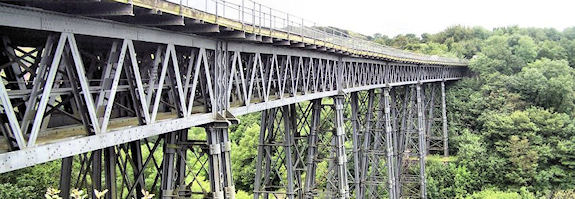
One of only two examples of a wrought iron truss girder viaduct in Britain.
Near Okehampton, Devon EX20 1AA
Meldon Viaduct's wrought and cast iron trestles carried their first train on 12th October 1874. Built by Engineer W R Galbraith for LSWR's Lydford-Okehampton line, the track sat 46m (150 ft) above the West Okement river valley on a rising gradient of 1 in 77 towards the west, incorporating a 30 chain radius curve. The Viaduct is located some 3 km (2 miles) south-west of Okehampton, adjacent to Meldon Quarry.
The wrought iron and cast iron structure is made up of six equal span warren trusses of ninety feet on five lattice trestles of wrought iron riveted together, of which the largest is 37 m (120 ft) tall, tapering significantly from base to apex. In 1878 the line was doubled and a second, broadly similar structure was erected to carry the new Down line with the Up line crossing on the older spans. The two viaducts were linked by extending deck members with bracing between the tops of the trestles, although the lower stages of the trestles were simply interlaced without connections above their common foundations.
The end spans of both viaducts sit on cast iron sliding bearings on concrete filled cast iron tubes which extend to depths of between 4.5 - 15 m (15 - 56 ft) immediately in front of the abutments. In spite of the fact that only four years separated their construction, there are a number of significant differences between the structures, most notable being the trestle construction. Although both sets of viaducts use the same Hughes patent piles in their legs, the cross bracing of the older trestles is slender wrought iron rod, compared with the more robust looking angle bracing of the later trestles. This remained the case until the 1960s, when the heavy additional bracing seen today was added.
The bottom chords of the trusses also differ in their construction, the later ones having greater lateral stiffness, although the older trusses were modified in later years to enhance their lateral stiffness. The whole of the viaduct was decked with 7.5 cm (3 inch) timber planking with large timber balks running longitudinally under the rails.
The exposed position of the viaduct and the forces exerted upon it by trains travelling around the curve resulted in speed and weight restrictions being imposed. In 1938 braces were added between the lower end of the older trestles and in 1944, in order to allow heavy wartime traffic, the outer trestle legs were weighted with additional concrete to resist uplift. The viaduct was further strengthened between 1959 and 1960 with the inner trestle legs being weighted and the up line trestle bracing being replaced with stronger section members.
In February 1999 the Meldon Viaduct Company was set up for the sole purpose of safeguarding and maintaining the Viaduct to ensure its future as a monument to Victorian engineering and as a valuable recreational resource. The shareholders are Aggregates Industries Ltd, Dartmoor National Park, Devon County Council and West Devon Borough Council.
Meldon Viaduct is one of only two examples of a wrought iron truss girder viaduct in Britain and its national
importance is recognised by protection as a Scheduled Monument. In 1996 the viaduct was refurbished as part of
the Dartmoor Way footpath and the Devon Coast to Coast cycle route. The panoramic views from the viaduct of
Dartmoor and beyond are just as breathtaking today as they would have been for Victorian train passengers.
By road: From Okehampton Town Centre turn south along George Street and take Station Road (signposted to Okehampton Station). Just before the bridge turn right (west) along the waymarked footpath/cycleway for 3.2 m (2 miles) to the Viaduct.
By bus & rail: by train from Exeter on summer Sundays and by bus from Exeter or Bude
Biddle, Gordon, Britain's Historic Railway Buildings, Oxford University Press, ISBN-10: 0198662475 (2003)
Biddle, Gordon & Nock, O.S., The Railway Heritage of Britain : 150 years of railway architecture and engineering, Studio Editions, ISBN-10: 1851705953 (1990)
Biddle, Gordon and Simmons, J., The Oxford Companion to British Railway History, Oxford, ISBN 0 19 211697 5 (1997)
Bonavia, Michael, Historic Railway Sites in Britain, Hale, ISBN 0 7090 3156 4 (1987)
Conolly, W. Philip, British Railways Pre-Grouping Atlas And Gazetteer, Ian Allan Publishing, ISBN 0-7110-0320-3 (1958/97)
Jowett, Alan, Jowett's Railway Atlas of Great Britain and Ireland, Patrick Stephens Ltd. ISBN 1-8526-0086-1. (March 1989)
Morgan, Bryan, Railways: Civil Engineering, Arrow, ISBN 0 09 908180 6 (1973)
Morgan, Bryan, Railway Relics, Ian Allan, ISBN 0 7110 0092 1 (1969)
Roche, T.W.E., The Withered Arm. Forge Books. (1967 reprinted 1984 and 1993)
Simmons, J., The Railways of Britain, Macmillan, ISBN 0 333 40766 0 (1961-86)
Simmons, J. The Victorian Railway, Thames & Hudson, ISBN 0 500 25110X (1991)
Smith, Martin, British Railway Bridges and Viaducts, Ian Allan, ISBN 0 7110 2273 9 (1994)
Turnock, David, An Historical Geography of Railways, Ashgate, ISBN 1 85928 450 7 (1998)

Devon County Council - Meldon Viaduct Case Study